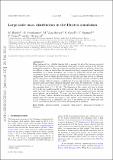| dc.contributor.author | Haider, M. | |
| dc.contributor.author | Steinhauser, D. | |
| dc.contributor.author | Genel, S. | |
| dc.contributor.author | Springel, V. | |
| dc.contributor.author | Hernquist, L. | |
| dc.contributor.author | Vogelsberger, Mark | |
| dc.contributor.author | Torrey, Paul A. | |
| dc.date.accessioned | 2017-05-01T17:47:41Z | |
| dc.date.available | 2017-05-01T17:47:41Z | |
| dc.date.issued | 2016-01 | |
| dc.date.submitted | 2015-12 | |
| dc.identifier.issn | 0035-8711 | |
| dc.identifier.issn | 1365-2966 | |
| dc.identifier.uri | http://hdl.handle.net/1721.1/108540 | |
| dc.description.abstract | Observations at low redshifts thus far fail to account for all of the baryons expected in the Universe according to cosmological constraints. A large fraction of the baryons presumably resides in a thin and warm–hot medium between the galaxies, where they are difficult to observe due to their low densities and high temperatures. Cosmological simulations of structure formation can be used to verify this picture and provide quantitative predictions for the distribution of mass in different large-scale structure components. Here we study the distribution of baryons and dark matter at different epochs using data from the Illustris simulation. We identify regions of different dark matter density with the primary constituents of large-scale structure, allowing us to measure mass and volume of haloes, filaments and voids. At redshift zero, we find that 49 per cent of the dark matter and 23 per cent of the baryons are within haloes more massive than the resolution limit of 2 × 10⁸ M⊙. The filaments of the cosmic web host a further 45 per cent of the dark matter and 46 per cent of the baryons. The remaining 31 per cent of the baryons reside in voids. The majority of these baryons have been transported there through active galactic nuclei feedback. We note that the feedback model of Illustris is too strong for heavy haloes, therefore it is likely that we are overestimating this amount. Categorizing the baryons according to their density and temperature, we find that 17.8 per cent of them are in a condensed state, 21.6 per cent are present as cold, diffuse gas, and 53.9 per cent are found in the state of a warm–hot intergalactic medium. | en_US |
| dc.language.iso | en_US | |
| dc.publisher | Oxford University Press | en_US |
| dc.relation.isversionof | http://dx.doi.org/10.1093/mnras/stw077 | en_US |
| dc.rights | Creative Commons Attribution-Noncommercial-Share Alike | en_US |
| dc.rights.uri | http://creativecommons.org/licenses/by-nc-sa/4.0/ | en_US |
| dc.source | arXiv | en_US |
| dc.title | Large-scale mass distribution in the Illustris simulation | en_US |
| dc.type | Article | en_US |
| dc.identifier.citation | Haider, M.; Steinhauser, D.; Vogelsberger, M.; Genel, S.; Springel, V.; Torrey, P. and Hernquist, L. “Large-Scale Mass Distribution in the Illustris Simulation.” Monthly Notices of the Royal Astronomical Society 457, no. 3 (February 24, 2016): 3024–3035. | en_US |
| dc.contributor.department | Massachusetts Institute of Technology. Department of Physics | en_US |
| dc.contributor.department | MIT Kavli Institute for Astrophysics and Space Research | en_US |
| dc.contributor.mitauthor | Vogelsberger, Mark | |
| dc.contributor.mitauthor | Torrey, Paul A. | |
| dc.relation.journal | Monthly Notices of the Royal Astronomical Society | en_US |
| dc.eprint.version | Author's final manuscript | en_US |
| dc.type.uri | http://purl.org/eprint/type/JournalArticle | en_US |
| eprint.status | http://purl.org/eprint/status/PeerReviewed | en_US |
| dspace.orderedauthors | Haider, M.; Steinhauser, D.; Vogelsberger, M.; Genel, S.; Springel, V.; Torrey, P.; Hernquist, L. | en_US |
| dspace.embargo.terms | N | en_US |
| dc.identifier.orcid | https://orcid.org/0000-0001-8593-7692 | |
| dc.identifier.orcid | https://orcid.org/0000-0002-5653-0786 | |
| mit.license | OPEN_ACCESS_POLICY | en_US |
